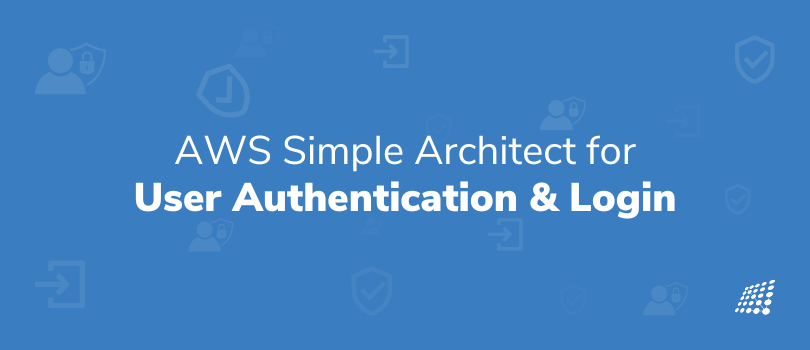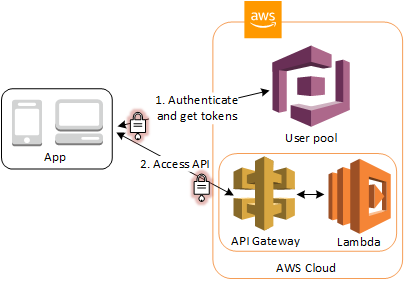AWS Simple Architect for User Authentication and Login

Imagine you have a mobile or web app that isn’t safe and secure to use. I know what you’re thinking. What’s the point of that mobile application anyway right? After all, it’s quite common, in today’s times, for security to be a big deal in any application that stores user data. Naturally, you need privacy and security when there is user interaction involved in the app or else it’s going to be chaos.
However, it becomes difficult and time-consuming to insert that added layer of security for seamless user data management and data storage owing to the privacy constraint. Sometimes, there are even cases where we need to integrate third-party social media authentication. For that, we need to manage that data as well which becomes even more tedious. But, we have a savior! To reduce the development time and effort, Amazon Web Services (AWS) came up with AWS Simple Architect, a robust solution that can be implemented using ‘Amazon Cognito’. Here is everything you need to know about AWS Cognito and how AWS Simple Architect for user authentication and login page can be used effectively among other things!
What is Amazon Cognito?
Amazon Cognito is an AWS authentication service that lets you add user sign-up, sign-in, and access control to your web and mobile apps quickly and easily.
- Amazon Cognito scales to millions of users and supports sign-in with social identity providers such as Apple, Facebook, Google, and Amazon, and enterprise identity providers via SAML 2.0 and OpenID Connect.
- It provides a secure identity store that scales to millions of users.
- It uses the secure remote password (SRP) protocol which makes it more secure and there is no scope for compromising the password when stored.
All in all, Amazon Cognito takes care of authentication so that you can focus on spending your time creating your apps the way you desire!
How does Amazon Cognito work?
Here’s a brief glimpse of how Amazon Cognito can be used and how AWS architecture for user authentication in AWS comes into progress.

Where can Amazon Cognito be used?
Since Amazon Cognito is highly scalable and can be easily integrated, it is suitable for any web application or mobile app where you have a serverless infrastructure. Amazon Cognito is even useful when you need to work with server-based applications. As it is an identity store, it becomes easier to manage access to various other AWS services such as S3 (where you store the data), and restrict the user from any unauthorized requests.
Main Components of Amazon Cognito
Now, let’s move on to the crucial components of Amazon Cognito to help you understand AWS architecture for login and registration better.
- User Pools: These are user directories that provide sign-up and sign-in options for your app users.
- Identity Pools: This enables you to grant your users access to other AWS services.
How does the User pool work?

As shown in the figure above (AWS architecture for user flow), the app sends user signup/login information using the Cognito authentication API and in return, the Cognito user pool sends the response with Cognito token, user metadata, and attributes. Thus, the token and other user information can be used to access other services of AWS or even for user authorization to access the data from data stores like S3.
The user pool stores the user data and it even allows importing the users from a CSV file. While creating the user pool there are options to connect the social identity providers and publicly available information from those platforms is pulled and stored in the user pool. Now, let’s move on to components of the user pool as it will give you a better understanding of AWS simple architect for user authentication and login API.
Components of User Pool:
The major components of the user pool are as follows:
- Users and groups: It lists the users who sign up to the Cognito and groups created either by identity providers or IAM users.
- Attributes: Involves metadata of the users which includes additional information such as name and address among other attributes.
- Policies: Defines the rules for user passwords.
- MFA and verifications: Helps to add multi-layer security and 2-factor authentication.
- Message customizations: For adding custom messages while sending the email for verification after signup.
- App clients: Allows access to the user pool which is used on client apps.
- Triggers: Allows the integration of the LAMBDA function on various events such as the pre-signup.
- App client settings: Configures the redirect URI and Cognito configuration.
- Domain name: If the app needs a custom domain, it can be updated here.
- UI customization: Used for making changes to how the frontend login page will look when using UI components for signup/login.
- Identity providers: Helps to integrate social identity providers along with openID.
- Attribute mapping: Helps map attributes from third-party providers with Cognito attributes.
Components of Identity pool
Here are the components of the Identity pool:
- Unauthenticated identities: Allow access to AWS services without logging in to the app.
- Authentication flow settings: To select the enhanced or classic flow for authentication.
- Authentication providers: To authenticate users with Cognito or public providers. A role can be mapped with an authenticated user to allow access to any AWS service and put the restrictions accordingly.
Many components in the Identity pool allow passing on the stream data to other services like Kinesis and can even have event triggers with LAMBDA integration.
Serverless Architecture While Using Cognito

To get started!
To get started with creating a user pool, all you have to do is follow this link! Alternatively, if you are looking to create an Identity pool, just follow this link.
All in all, there are many areas where Amazon Cognito can be used efficiently and seamlessly such as very simple apps to most complex user management. If you need any more information on how to create a Cognito user pool/identity pool, the benefits of using it, AWS simple architect for user authentication and login page, or want to know more about AWS Cloud Services in general, get in touch with us! We will give you our unbiased views on the power and potential of AWS. I also hope to share many more insights and technical blogs in the future. Until then, stay tuned!
Thank you for your time and please let me know if you find this article helpful

The Story of My First Acquia Certification

Coding Tips, Duke Experience


